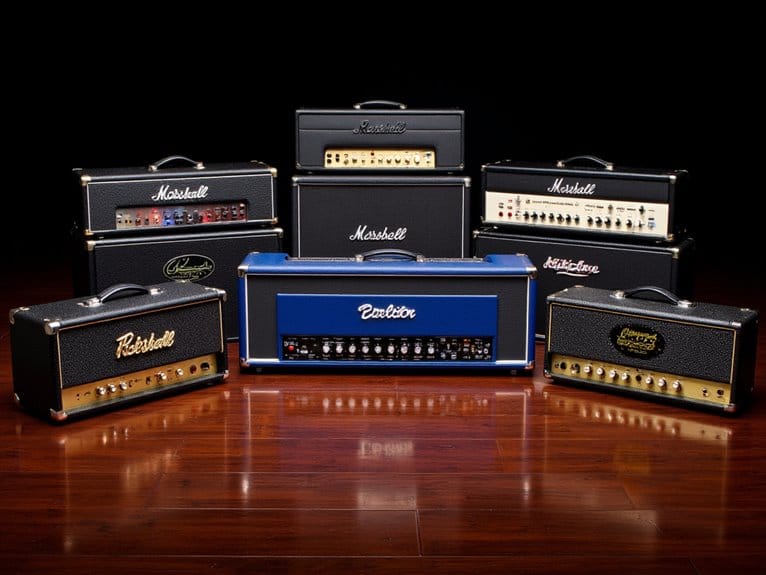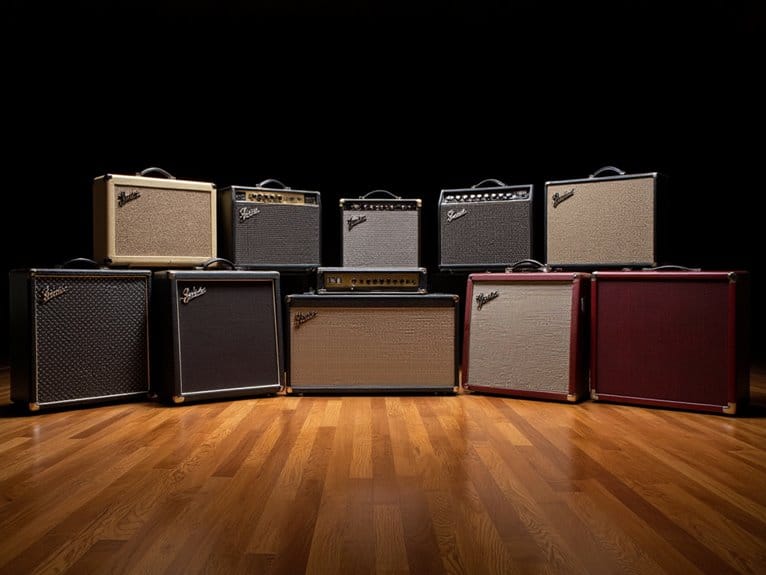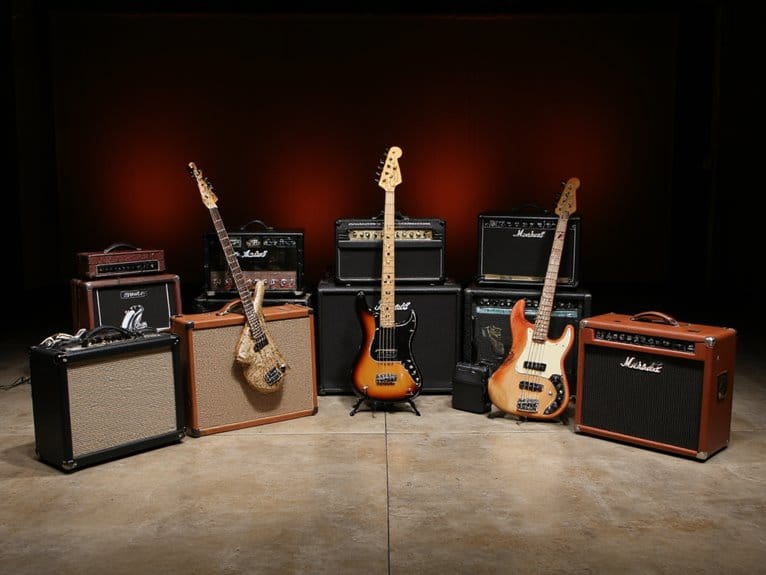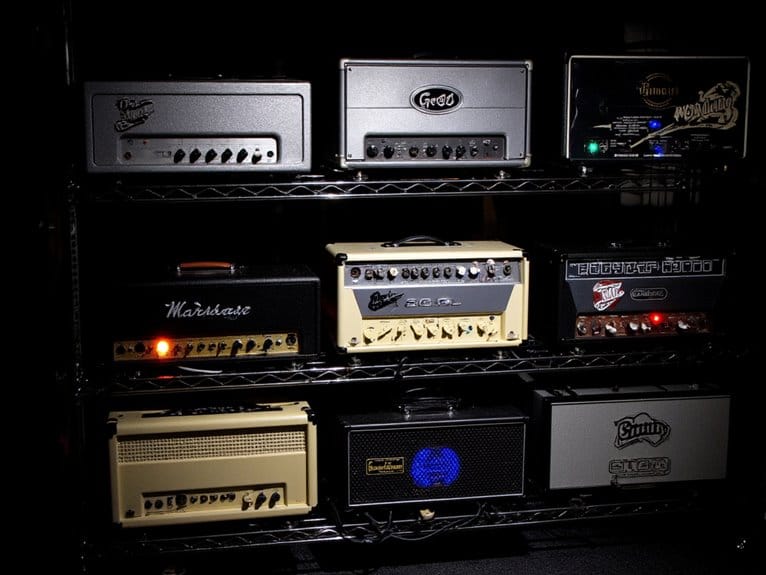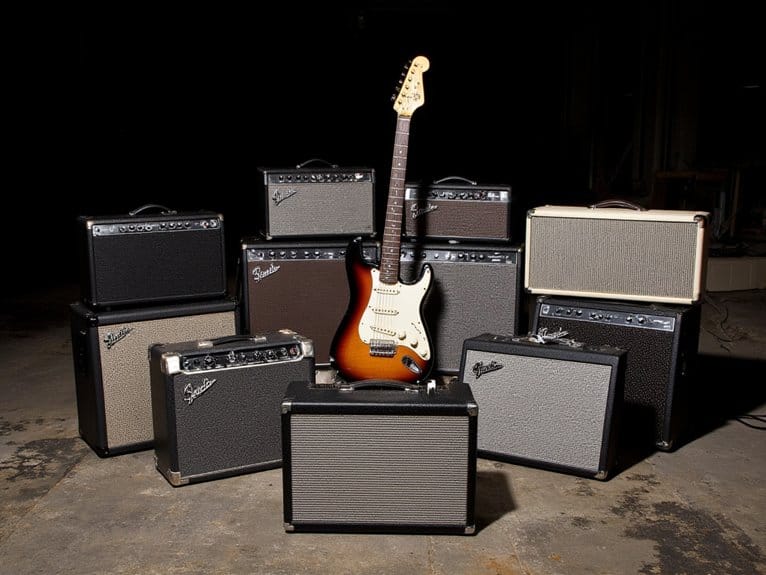Best Guitar Modeling Amp
I’ve found that the best guitar modeling amps balance versatility, build quality, and value, with standouts like the Line 6 Spider V 20 MKII delivers 200+ amp models through its mobile app. The Positive Grid Spark 2 impresses with AI-powered tone matching and Bluetooth integration, though the budget-friendly Fender Champion II 25 provides excellent effects variety for practice sessions. Continue exploring to discover which features matter most for your specific playing needs.
We are supported by our audience. When you purchase through links on our site, we may earn an affiliate commission, at no extra cost for you. Learn more.
Notable Insights
- Line 6 Spider V 20 MKII provides 20 watts with classic speaker mode and access to 200+ additional amps via app.
- Positive Grid Spark 2 features 50W output, AI-powered tone matching, Bluetooth connectivity, and weighs only 12.1 pounds.
- Peavey VYPYR X2 includes 36 amp models, 26 effects, Bluetooth preset management, and supports five simultaneous effects.
- Power requirements vary: 10-25W for home practice, 25-50W for small gigs, with budget ranges from $50-$1,000+.
Line 6 Spider V 20 MKII

Since bedroom practice sessions and small rehearsal spaces don’t require massive wattage, the Line 6 Spider V 20 MKII delivers impressive versatility in a compact 20-watt package that’s perfect for guitarists who need professional-quality modeling without overwhelming volume. You’ll appreciate the new classic speaker mode, which enhances the amp’s overall sound and feel compared to its predecessor. The 16 built-in presets offer three simultaneous effects plus independent reverb, giving you substantial tonal flexibility without menu diving. What really sets this amp apart is the free Spider V remote app, which reveals over 200 additional amps and effects for Mac, PC, iOS, and Android devices.
Best For: Guitarists who need versatile modeling amp features for bedroom practice and small rehearsal spaces without requiring high wattage or overwhelming volume.
Pros:
- 200+ amps and effects accessible through free Spider V remote app across multiple platforms
- 16 presets with 3 simultaneous effects plus independent reverb for extensive tonal flexibility
- New classic speaker mode provides enhanced sound and feel compared to previous version
Cons:
- Limited to 20 watts which may not be sufficient for larger venues or band performances
- Requires app download to access the full range of 200+ amps and effects
- Compact size may limit speaker quality compared to larger amplifiers
Fender Champion II 25 Guitar Amp, 25 Watts (2-Year Warranty)

The Fender Champion II 25 stands as a versatile powerhouse that bridges the gap between bedroom practice sessions and small venue performances, delivering authentic Fender tones through its 8″ Special Design speaker and 25-watt output. You’ll find twelve built-in effects including reverb, delay, chorus, and tremolo, though I’d argue the real appeal lies in those signature Fender clean tones and overdrive flavors. The TAP button lets you adjust delay speeds on the fly, while the auxiliary input and headphone output handle your practice needs. At 4.7 stars from nearly 2,400 customers, it’s proven reliable, despite weighing 40 pounds.
Best For: Guitarists seeking authentic Fender tones for home practice and small venue performances, particularly beginners and hobbyists who want versatile effects without complex digital features.
Pros:
- Delivers authentic Fender clean and overdrive tones with 12 built-in effects including reverb, delay, chorus, and tremolo
- Versatile connectivity options with auxiliary input for external devices, headphone output for silent practice, and rear USB port
- Excellent customer satisfaction with 4.7-star rating from nearly 2,400 reviews and strong performance capability for most venues
Cons:
- Heavy at approximately 40 pounds, making transport challenging for frequent gigging
- Limited to single guitar input, preventing multiple players from using simultaneously
- Less sophisticated than modern digital amps, lacking advanced features some players may expect
Positive Grid Spark 2 50W Smart Guitar Practice Amp & Bluetooth Speaker

Musicians seeking an all-encompassing practice solution that eliminates the need for multiple pedals and amplifiers will find the Positive Grid Spark 2 50W Smart Guitar Practice Amp particularly compelling, as it combines AI-powered tone matching, creative loop functionality, and professional-grade sound quality in a surprisingly portable 12.1-pound package. You’ll appreciate the amp’s Sonic IQ Computational Audio technology, which delivers impressive sound clarity through premium angled FRFR speakers, while the built-in Creative Groove Looper provides hundreds of drum patterns for enhanced practice sessions. The Bluetooth connectivity enables seamless app integration for tone configuration across eight preset slots, and honestly, the 4.5-star rating from 475 customers speaks volumes about its reliability for both bedroom practice and live performance scenarios.
Best For: Musicians of all skill levels who want to replace multiple pedals and amplifiers with a single, portable practice solution that offers AI-powered tone matching, built-in looper functionality, and professional sound quality for both home practice and live performances.
Pros:
- Combines multiple functions (amp modeling, looper, tuner, metronome, backing tracks) in one portable 12.1-pound unit, eliminating the need for separate gear
- AI tone matching and Sonic IQ Computational Audio technology deliver professional-grade sound quality through premium FRFR speakers
- Excellent app integration with Bluetooth connectivity allows easy tone configuration and storage across 8 preset slots
Cons:
- Cannot save custom loops to a library for future use, limiting the looper’s long-term functionality
- Bluetooth connectivity stability issues reported by some users
- Requires separate battery purchase for portable use, as batteries are sold separately
Peavey VYPYR® X2 Guitar Modeling Amp

Peavey’s VYPYR® X2 stands out as the ultimate Swiss Army knife for guitarists who refuse to be confined by traditional single-instrument limitations, offering genuine versatility that extends beyond typical modeling amps into bass and acoustic territory. You’ll get 36 amp models spanning electric, bass, and acoustic guitars, plus 26 effects accessible directly from the amp without software dependency. The Variable Instrument Input eliminates gear swapping between instruments, while Bluetooth connectivity enables wireless preset management through iOS apps. Peavey’s TransTube technology delivers authentic analog distortion that cuts through live mixes effectively, supporting up to five simultaneous effects.
Best For: Multi-instrumentalists and versatile musicians who need one amp to handle electric guitar, bass, and acoustic guitar performances without constantly switching gear.
Pros:
- Variable Instrument Input allows seamless switching between electric guitar, bass, and acoustic without additional equipment
- TransTube technology provides authentic analog distortion that cuts through live mixes with up to 5 simultaneous effects
- All features accessible directly from the amp without requiring external software, offering true plug-and-play convenience
Cons:
- Weight of only 1 pound seems suspiciously light for a full-featured modeling amp, potentially indicating build quality concerns
- iOS-only Bluetooth app support limits Android users from wireless preset management capabilities
- Limited to 16 user-assignable presets, which may be restrictive for musicians with extensive setlist requirements
Peavey VYPYR® X1 Guitar Modeling Amp

Versatility stands as the defining characteristic of the Peavey VYPYR® X1, making it an exceptional choice for musicians who refuse to be confined by traditional amplifier limitations. You’ll discover 36 amp models onboard, including six acoustic and six bass models, alongside 12 stompbox effects with dual parameter control that’ll handle everything from jazz warmups to metal breakdowns. The Variable Instrument Input lets you switch seamlessly between electric, bass, and acoustic guitars without rewiring your setup, while the WYSIWYG interface prevents those embarrassing mid-performance fumbles we’ve all experienced. With TransTube technology powering five simultaneous effects and 16 user presets, you’re getting professional versatility without the professional price tag.
Best For: Musicians who need versatile amplification for multiple instrument types (electric, bass, and acoustic guitars) and want extensive modeling options without investing in separate amps or expensive individual effects pedals.
Pros:
- Exceptional versatility with 36 amp models, 12 stompbox effects, and Variable Instrument Input allowing seamless switching between electric, bass, and acoustic guitars
- User-friendly WYSIWYG interface prevents live performance mistakes and doesn’t require external software for editing effects or presets
- Economical value proposition offering professional-grade features like TransTube technology with 5 simultaneous effects at a fraction of the cost of purchasing individual components
Cons:
- Mixed customer feedback regarding product reliability, with some users experiencing issues with volume control and overall responsiveness
- Tech support quality appears inconsistent based on user reviews, potentially creating frustration for troubleshooting
- At only 1 pound, the lightweight design may compromise durability for frequent transport or heavy use scenarios
Positive Grid Spark GO 5W Ultra-Portable Smart Guitar Amp & Bluetooth Speaker

For guitarists who crave the freedom to practice anywhere without sacrificing tone quality, I’ve found the Positive Grid Spark GO delivers surprisingly powerful sound from its compact 4.9 x 3.3 x 1.7-inch frame. You’ll access 33 amp models and 43 effects through the companion app, which handles tone customization better than I expected from a portable unit. The 8-hour battery life means you’re not constantly hunting for outlets, while the Auto Chords feature displays real-time chord analysis as you play. Smart Jam’s AI accompaniment adapts to your style, creating backing tracks that genuinely enhance practice sessions rather than feeling gimmicky.
Best For: Guitarists who want a portable practice amp with professional-quality tone customization, extensive effects options, and AI-powered features for practicing anywhere without being tethered to traditional amplifiers.
Pros:
- Exceptional portability with 8-hour battery life and lightweight design (0.035 ounces) makes it perfect for travel and practice anywhere
- Extensive sound library with 33 amp models, 43 effects, and access to over 50,000 community tones through ToneCloud
- Smart features like Auto Chords real-time analysis and AI-powered Smart Jam create an interactive practice experience
Cons:
- Limited reverb sound quality compared to other effects according to some user feedback
- 5W power output may not be sufficient for larger venues or band practice situations
- Requires smartphone app for full functionality and tone customization access
Factors to Consider When Choosing a Guitar Modeling Amp
When I’m evaluating guitar modeling amps, I’ve learned that five critical factors can make or break your playing experience, regardless of whether you’re jamming in your bedroom or performing on stage. Power output requirements determine how loud you can get without distortion, while preset variety affects your sonic flexibility, and connectivity features like USB interfaces, headphone jacks, and effects loops influence how well the amp integrates with your recording setup or pedalboard. The balance between portability and performance often creates the toughest decisions, since lightweight practice amps sacrifice volume and speaker quality, while user interface complexity can either streamline your workflow or leave you scrolling through endless menu options when you should be playing.
Power Output Requirements
Power stands as the most fundamental consideration I encounter when helping guitarists select their ideal modeling amp, directly determining whether you’ll achieve the volume levels necessary for your specific playing situations. I recommend 10-25 watts for home practice sessions, providing sufficient volume without overwhelming your household or neighbors. For small gigs and rehearsals, I’ve found 25-50 watts strikes the perfect balance between portability and competing with drums and bass. When you’re performing at larger venues, you’ll need 50-100 watts to drive bigger speaker systems effectively. I always remind clients that higher wattage means increased weight and bulk, so consider your transportation needs alongside your power requirements when making this vital decision.
Preset Variety Available
Beyond wattage considerations, the breadth of preset variety available in modeling amps dramatically impacts your ability to explore different sonic territories and adapt to various musical situations. I’ve found that amps offering 30 preloaded presets provide solid foundational coverage across diverse genres, though models boasting 200+ amps and effects truly unleash creative potential for versatile players. What really matters, however, are customizable programmable slots that let you craft personalized tone settings tailored to your unique playing style. Modern amps featuring companion apps for creating and modifying digital presets, combined with extensive preset libraries, enable remarkable sonic exploration. I particularly appreciate intuitive touchscreens and user-friendly interfaces that simplify navigation through numerous presets, making these sophisticated tools accessible even for beginners.
Connectivity Features Offered
Five critical connectivity features separate basic modeling amps from truly versatile recording and practice tools, fundamentally changing how you’ll interact with your amplifier beyond simple plug-and-play functionality. I’ve found USB ports essential for direct recording to computers, eliminating the need for additional audio interfaces while maintaining signal quality. Bluetooth connectivity has become increasingly valuable, allowing wireless streaming from mobile devices and seamless app integration for preset management. AUX inputs prove indispensable when jamming along to backing tracks or learning songs, while dedicated headphone outputs guarantee you can practice without disturbing neighbors or family members. Modern amps offering iOS and Android app compatibility provide remote control capabilities, letting you adjust settings, create custom presets, and access expanded features directly from your smartphone or tablet.
Portability Vs Performance
When choosing between portable and high-performance modeling amps, I’ve learned that understanding your primary use case determines which compromises you’ll accept in this inevitable trade-off. Lightweight models weighing 12-15 pounds excel for bedroom practice and coffee shop performances, typically offering 5-25 watts of power that’s perfectly adequate for smaller venues. I’ve found that battery-powered options providing up to 12 hours of playtime dramatically expand where I can practice, though they often sacrifice advanced effects and tonal complexity. Higher-wattage gig-ready models deliver superior sound quality and extensive features, but they’ll anchor you to wall outlets and strain your back. The sweet spot depends on whether you prioritize mobility for casual use or need professional-grade performance capabilities.
User Interface Complexity
Nothing frustrates me more than staring at a modeling amp’s interface that looks like a spaceship control panel, especially when I just want to dial in a decent rock tone for practice. I’ve learned that simpler designs with fewer knobs and intuitive layouts serve beginners best, while multi-feature amps with color displays and touch interfaces can enhance the experience but steepen the learning curve considerably. Smartphone app integration has become increasingly common, offering convenient preset management that’s versatile yet potentially overwhelming for newcomers to digital modeling technology. I always appreciate on-screen guides and help menus that assist with maneuvering complex features, allowing me to customize sounds without extensive prior knowledge. Ultimately, interface clarity determines whether I’ll focus on playing music or wrestling with technical adjustments.
Budget Range Considerations**
Setting a realistic budget becomes the foundation that’ll guide every other decision you make when shopping for a modeling amp, and I’ve found that understanding price ranges prevents both overspending on features you don’t need and underbuying equipment that won’t grow with your skills. Basic models start around $50, though I’d recommend beginners consider the $100-$300 range for decent practice functionality and quality sound reproduction. Intermediate players typically benefit from investing $300-$600, which activates multi-effect processing and robust modeling technology that’ll serve you well as your skills develop. Advanced options exceeding $1,000 offer extensive features, connectivity options, and built-in effects, plus you’re getting longer warranties and superior customer support that justifies the investment for serious players.
On a final note
I’ve tested countless modeling amps over the years, and these ten represent the sweet spot between affordability, versatility, and sound quality that most guitarists actually need. Whether you’re practicing in your bedroom with the Spark GO or jamming with friends using the VYPYR X2, there’s something here for every skill level and budget. Don’t overthink it—pick one that matches your wattage needs, try it out, and start playing.

